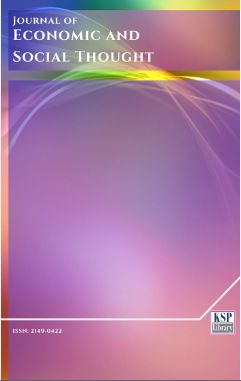Technological change as intelligent, energy-maximizing adaptation
Abstract
Abstract. The picture of technological change over the last 70 years in the global economy is ambiguous, with two salient facts: Total Factor Productivity has been systematically falling since 1979, whilst the average global food deficit has been systematically declining since 1992. Building upon those two fundamental facts, this article develops and verifies empirically a model, where technological change is a function of intelligent adaptation, which maximizes the appropriation of energy from the environment. Empirical research presented in the article suggests that food deficit is a powerful spur of technological change, and the loop between said change and appropriation of energy works is the most visible in societies with such deficit. As the human civilisation has managed to cut the average food deficit by half, since 1992, whist doubling population, we might be, right now, at the historical peak of intensity in technological change.
Keywords. Technological change, Evolutionary theory, Intelligent adaptation.
JEL. O3, O4, Q01.Keywords
References
Arrow, K.J. (1962). Economic welfare and the allocation of resources for invention, in: Nelson R. (ed.), The Rate and Direction of Inventive Activity: Economic and Social Factors, NBER Princeton University Press. [Retrieved from].
Arrow, K.J. (1969). The Firm in General Equilibrium Theory, Technical Report No. 3, Prepared Under Contract No. N00014-67A-0298-0019, Project no. NR 047-004, Harvard University, May.
Bayes, P. (1763). An essay towards solving a problem in the doctrine of chances, by the late rev. Mr Bayes, first communicated by MrPrice, in a letter to John Canton, (pp.370-418), Philosophical Transactions.
Cobb, C.W., & Douglas, P.H. (1928). A theory of production, The American Economic Review, 18(1), 139-165.
Eaton, J., & Kortum, S. (1999). International technology diffusion: Theory and measurement, International Economic Review, 40(3), 537-565. doi. 10.1111/1468-2354.00028
Ewing Marion Kauffman Foundation, (2011). Rules For Growth. Promoting Innovation and Growth Through Legal Reform. [Retrieved from].
Feenstra, R.C., Inklaar, R., &Timmer, M.P., (2015). The next generation of the penn world table, American Economic Review, 105(10), 3150-3182. doi. 10.1257/aer.20130954
Frantzen, D. (2000). Innovation, technological diffusion and the influence of R&D, Cambridge Journal of Economics, 24(2), 193-210. doi. 10.1093/cje/24.2.193
International Bank for Reconstruction and Development, (2016). The World Development Report: Digital Dividends, World Bank. doi. 10.1596/978-1-4648-0671-1
Jaffe, A., Bound, J., Cummins, C., Griliches, Z., & Hall, B.H., (1982). Who does R&D and who patents?, NBER Working Papers, No.908. doi. 10.3386/w0908
Kamien, M.I., & Schwartz, N.L. (1982). Market Structure and Innovation, Cambridge Universitry Press, Cambridge.
Lo, A.W. (2005). Reconciling efficient markets with behavioral Finance: The adaptive markets hypothesis, The Journal of Investment Consulting, 7(2), 1-24.
Loury, G.C. (1979). Market structure and innovation, Quarterly Journal of Economics, 93(3), 395-410. doi. 10.2307/1883165
Nash, J. (1951). Non-cooperative games, The Annals of Mathematics, 54(2), 286-295. doi. 10.2307/1969529
Nelson, R.R., & Pack, H. (1997). The Asian miracle and modern growth theory, The World Bank, October. doi. 10.1596/1813-9450-1881
Phelps, E.S. (1964). Models of technical progress and the golden rule of research, Cowles Foundation, Discussion Paper, No.176.
Selten, R. (1975). Reexamination of the perfectness concept for equilibrium points in extensive games, International Journal of Game Theory, 4(1), 25-55. doi. 10.1007/978-94-015-7774-8_1
Scherer, F.M. (1967). Research and development under rivalry, Quarterly Journal of Economics, 81(3), 359-394. doi. 10.2307/1884807
Schumpeter, J.A. (1939). Business Cycles. A Theoretical, Historical and Statistical Analysis of the Capitalist Process. McGraw-Hill Book Company.
Simon, A.H. (1955). A behavioral model of rational choice, Quarterly Journal of Economics, 69(1), 99-118. doi. 10.2307/1884852
DOI: http://dx.doi.org/10.1453/jest.v4i3.1410
Refbacks
- There are currently no refbacks.
Journal of Economic and Social Thought - J. Econ. Soc. Thoug. - JEST - www.kspjournals.org
ISSN: 2149-0422
Editor: jest@ksplibrary.org Secretarial: secretarial@ksplibrary.org Istanbul - Turkey.
Copyright © KSP Library




